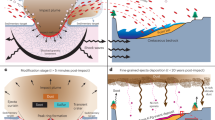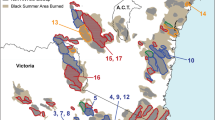Abstract
An iridium anomaly at the Cretaceous/Tertiary boundary layer has been attributed to an extraterrestrial body that struck the Earth some 65 million years ago1. It has been suggested that, during this event, the carrier of iridium was probably a micrometre-sized silicate-enclosed aggregate2 or the nanophase material of the vaporized impactor3. But the fate of platinum-group elements (such as iridium) that regularly enter the atmosphere via ablating meteoroids remains largely unknown. Here we report a record of iridium and platinum fluxes on a climatic-cycle timescale, back to 128,000 years ago, from a Greenland ice core4. We find that unexpectedly constant fallout of extraterrestrial matter to Greenland occurred during the Holocene, whereas a greatly enhanced input of terrestrial iridium and platinum masked the cosmic flux in the dust-laden atmosphere of the last glacial age. We suggest that nanometre-sized meteoric smoke particles5,6, formed from the recondensation of ablated meteoroids in the atmosphere at altitudes >70 kilometres, are transported into the winter polar vortices by the mesospheric meridional circulation7 and are preferentially deposited in the polar ice caps. This implies an average global fallout of 14 ± 5 kilotons per year of meteoric smoke during the Holocene.
This is a preview of subscription content, access via your institution
Access options
Subscribe to this journal
Receive 51 print issues and online access
$199.00 per year
only $3.90 per issue
Buy this article
- Purchase on Springer Link
- Instant access to full article PDF
Prices may be subject to local taxes which are calculated during checkout


Similar content being viewed by others
References
Alvarez, L. W., Alvarez, W., Asaro, F. & Michel, H. V. Extraterrestrial cause for the Cretaceous/Tertiary extinction. Science 208, 1095–1108 (1980)
Schuraytz, B. C. et al. Iridium metal in Chicxulub impact melt: forensic chemistry on the K-T smoking gun. Science 271, 1573–1576 (1996)
Wdowiak, T. J. et al. Presence of an iron-rich nanophase material in the upper layer of the Cretaceous-Tertiary boundary clay. Meteorit. Planet. Sci. 36, 123–133 (2001)
Dansgaard, W. et al. Evidence for general instability of past climate from a 250-kyr ice core record. Nature 364, 218–220 (1993)
Hunten, D. M., Turco, R. P. & Toon, O. B. Smoke and dust particles of meteoric origin in the mesosphere and stratosphere. J. Atmos. Sci. 37, 1342–1357 (1980)
Love, S. G. & Brownlee, D. E. Heating and thermal transformation of micrometeoroids entering the Earth's atmosphere. Icarus 89, 26–43 (1991)
Prather, M. J. & Rodriguez, J. M. Antarctic ozone: meteoric control of HNO3 . Geophys. Res. Lett. 15, 1–4 (1988)
Johnsen, S. J. et al. Oxygen isotope and palaeotemperature records from six Greenland ice-core stations: Camp Century, Dye-3, GRIP, GISP2, Renland and NorthGRIP. Quat. Sci. 16, 299–307 (2001)
Wedepohl, K. H. The composition of the continental crust. Geochim. Cosmochim. Acta 59, 1217–1232 (1995)
Hong, S., Candelone, J. P. & Boutron, C. F. Changes in zinc and cadmium concentrations in Greenland ice during the past 7760 years. Atmos. Environ. 31, 2235–2242 (1997)
Zoller, W. H., Parrington, J. R. & Kotra, J. M. P. Iridium enrichment in airborne particles from Kilauea Volcano: January 1983. Science 222, 1118–1121 (1983)
Anders, E. & Grevesse, N. Abundances of the elements: Meteoritic and solar. Geochim. Cosmochim. Acta 53, 197–214 (1989)
Karner, D. B. et al. Extraterrestrial accretion from the GISP2 ice core. Geochim. Cosmochim. Acta 67, 751–763 (2003)
Gabrielli, P. et al. Determination of Ir and Pt down to the sub-femtogram per gram level in polar ice by ICP-SFMS using preconcentration and a desolvation system. J. Anal. At. Spectrom. 19, 831–837 (2004)
Love, S. G. & Brownlee, D. E. A direct measurement of the terrestrial mass accretion rate of cosmic dust. Science 262, 550–553 (1993)
Plane, J. M. C. A new time-resolved model of the mesospheric Na layer: constraints on the meteor input function. Atmos. Chem. Phys. Discuss. 4, 39–69 (2004)
Mathews, J. D., Janches, D., Meisel, D. D. & Zhou, Q. H. The micrometeoroid mass flux into the upper atmosphere: Arecibo results and a comparison with prior estimates. Geophys. Res. Lett. 28, 1929–1932 (2001)
Manson, A. H. et al. Comparison between reference atmosphere winds and radar winds from selected locations. Adv. Space Res. 10, 233–243 (1990)
Hughes, D. W. in Cosmic Dust (ed. McDonnel, J. A. M.) 123–185 (Wiley, London, 1978)
Ravizza, G. & Pyle, D. PGE and Os isotopic analysis of single sample aliquots with NiS fire assay preconcentration. Chem. Geol. 141, 251–268 (1997)
Svensson, A., Biscaye, P. E. & Grousset, F. E. Characterization of late glacial continental dust in the Greenland Ice Core Project ice core. J. Geophys. Res. 105, 4637–4656 (2000)
Muller, R. A. & MacDonald, G. J. Glacial cycles and orbital inclination. Nature 377, 107–108 (1995)
Boutron, C. F. & Patterson, C. C. Lead concentration changes in Antarctic ice during the Wisconsin/Holocene transition. Nature 323, 222–225 (1986)
Hong, S. et al. Climate-related variations in lead concentrations and sources in Vostok Antarctic ice from 65,000 to 240,000 years BP. Geophys. Res. Lett. 30, 2138–2142 (2003)
Peucker-Ehrenbrink, B. & Ravizza, G. The effects of sampling artifacts on cosmic dust flux estimates: A reevaluation of nonvolatile tracers (Os, Ir). Geochim. Cosmochim. Acta 64, 1965–1970 (2000)
Taylor, S., Lever, J. H. & Harvey, R. Accretion rate of cosmic spherules measured at the South Pole. Nature 392, 899–903 (1998)
Barbante, C. et al. Determination of Rh, Pd, and Pt in polar and alpine snow and ice by double-focusing ICPMS with microcentric nebulization. Anal. Chem. 71, 4125–4133 (1999)
Brown, P., Spalding, R. E., ReVelle, D. O., Tagliaferri, E. & Worden, S. D. The flux of small near-Earth objects colliding with the Earth. Nature 420, 294–296 (2002)
Maurette, M., Jehanno, C., Robin, E. & Hammer, C. U. Characteristics and mass distribution of extraterrestrial dust from the Greenland ice cap. Nature 328, 699–702 (1987)
Jacobson, M. Z., Lu, R., Jensen, E. J. & Toon, O. B. Modelling coagulation among particles of different composition and size. Atmos. Environ. A 28, 1327–1338 (1994)
Acknowledgements
This work was supported in France by the Institut Universitaire de France, the Ministère de l'Environnement et de l'Amènagement du Territoire, the Agence de l'Environnement et de la Maîtrise de l'Energie, the Institut National des Sciences de l'Univers and the Université Joseph Fourier of Grenoble. In Italy, it was supported by the Antarctic National Research Programme, and in the UK, by the Natural Environment Research Council. We thank G. McFiggans for discussions regarding the aerosol growth model. This research was also supported by two Marie Curie fellowships of the European Community programme (IHP) and by the Alliance for Global Sustainability. This work is a contribution of GRIP organized by the European Science Foundation: we thank all the personnel working in the field in Greenland.
Author information
Authors and Affiliations
Corresponding author
Ethics declarations
Competing interests
The authors declare that they have no competing financial interests.
Supplementary information
Supplementary Method 1
This section illustrates the quantification of the procedural blank related to the pre-concentration procedure of Greenland ice samples. (DOC 31 kb)
Supplementary Table 1
This table shows the Ir and Pt concentrations measured in Greenland ice with the associated instrumental standard deviation from 100 acquisitions. (DOC 111 kb)
Supplementary Figure 1
This figure shows how the procedural blank was determined in the section Supplementary Method 1. The mass (in fg) of Ir (a) and Pt (b) released/adsorbed to/from the solution during the pre-concentration procedure is the intercept of the regression line of the Ir and Pt masses measured vs. different initial masses of pre-concentrated ultra pure water. The error bars given are the instrumental standard deviations from 100 acquisitions. (DOC 39 kb)
Supplementary Figure 2
This figure shows a comparison of different extraterrestrial accretion rate estimates as shown in Table 1. Our direct measurement estimate of 78 kt yr-1 is slightly larger also than the commonly accepted value of around 40 kt yr-1 (ref. 15) whereas our estimation of the corrected average global fallout of 14 kt yr-1(see text) agrees well with other recent different estimates. (DOC 69 kb)
Rights and permissions
About this article
Cite this article
Gabrielli, P., Barbante, C., Plane, J. et al. Meteoric smoke fallout over the Holocene epoch revealed by iridium and platinum in Greenland ice. Nature 432, 1011–1014 (2004). https://doi.org/10.1038/nature03137
Received:
Accepted:
Issue Date:
DOI: https://doi.org/10.1038/nature03137
Comments
By submitting a comment you agree to abide by our Terms and Community Guidelines. If you find something abusive or that does not comply with our terms or guidelines please flag it as inappropriate.



